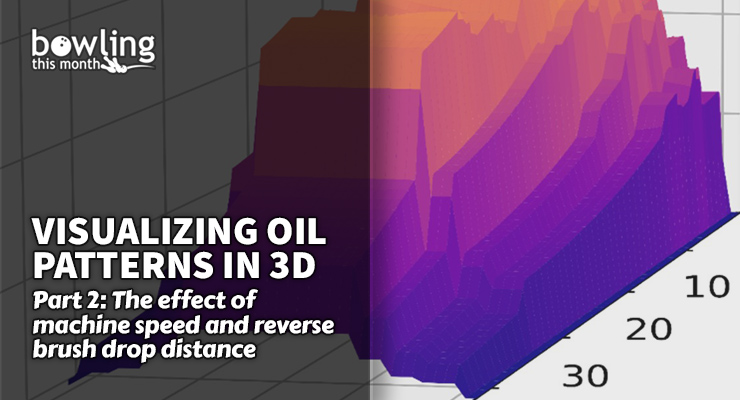Article Contents
- 1. Speed
- 2. Reverse brush drop
- 3. Conclusion
Note: This article is only available to Bowling This Month subscribers.
Welcome to the second article of three in this series, where Kegel oil patterns are visualised in three dimensions. I would recommend reading the first article if you have not already done so, to get a flavor for the series and to see the 3D graphs of some typical oil patterns.
In this article, we will investigate the effect of two important features of the lane machine on the shape of the oil pattern. The first setting we will study is the speed at which the machine travels while applying oil to the lane. The second setting we will look at is the distance of the reverse brush drop.
Speed
Kegel lane machines can travel along the lane at six different speeds while applying oil to the lane surface. The unit for the speed setting is inches per second, and the six speeds at which the machine can travel are 10, 14, 18, 22, 26, and 30 inches per second. The speed of the machine is greatly responsible for controlling the front-to-back taper of the oil, which itself plays a huge part in determining the overall characteristics of the oil pattern, as discussed in the previous article.
Generally, the lane machine will start off at one of the slower speeds to begin oiling on the forward pass. As the machine progresses downlane toward the pins, the speed is generally set to increase, and it is not uncommon for 30 inches per second to be reached just before the pattern length is reached. On the reverse pass, oiling commences when the reverse brush drop distance is reached, at which point the buffer brush drops and resumes its contact with the lane. Typically, this is close to the end of the oil pattern, and the lane machine will once again be traveling at one of the faster speeds. As it approaches the foul line, the machine will tend to slow down.
The motivations for this sequence of speeds are to ensure that a greater volume of oil is placed at the beginning of the lane close to the foul line compared to the end of the pattern, and that there is a smooth, gradual decrease in oil with distance from the foul line. To ...
Already a premium member? Click here to log in.


